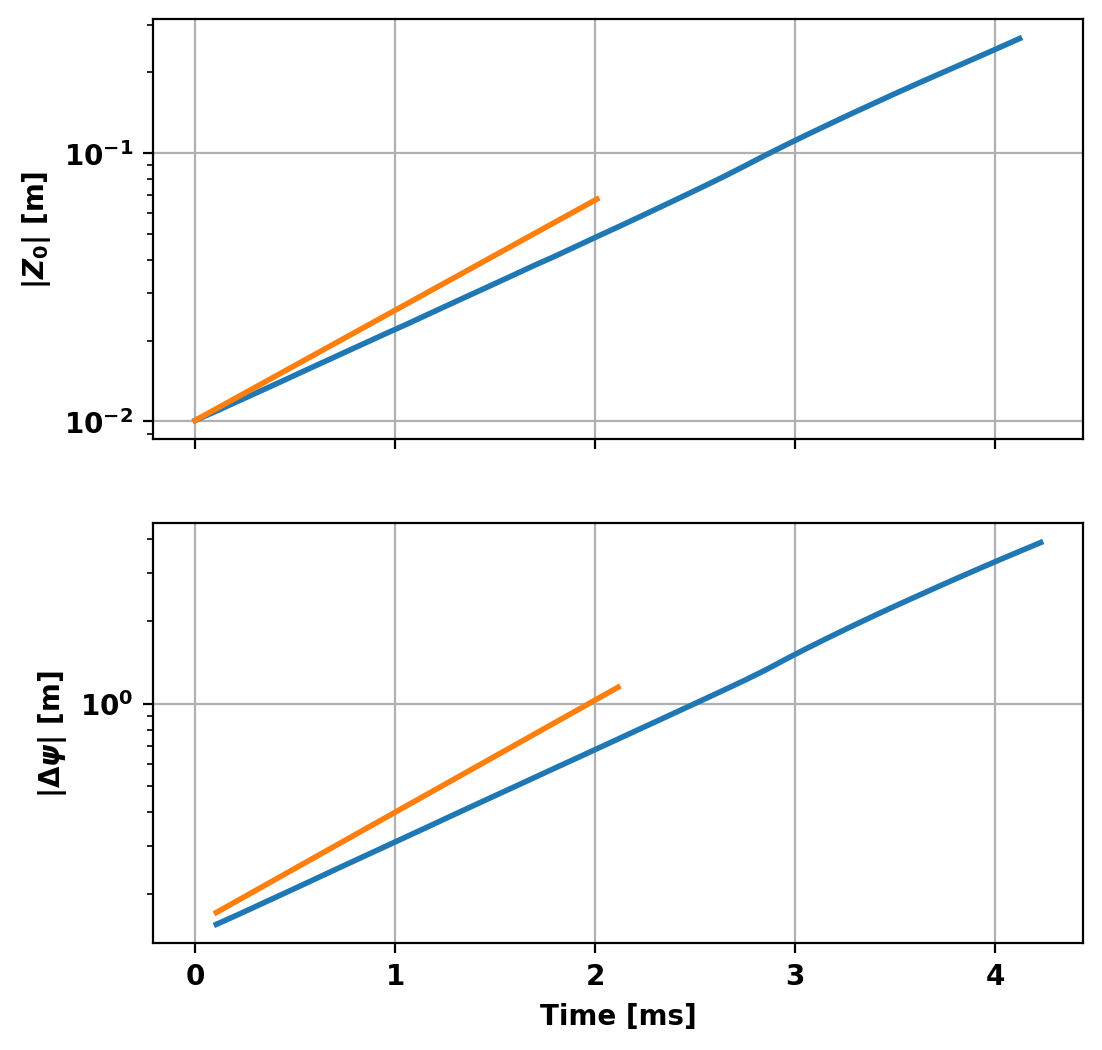In this example we demonstrate:
1) How to reproduce a DIII-D equilibrium using an inverse solve from EFIT by reading in inputs from a gEQDSK file. 2) How to reproduce a DIII-D equilibrium using an forward solve from EFIT by reading in inputs from a gEQDSK file. 3) How to compute linear growth rates and perform time-dependent simulation of a Vertical Displacement Event (VDE) using this equilibrium
This example utilizes the mesh built in TokaMaker Meshing Example: Building a mesh for DIII-D.
- Note
- Running this example requires the h5py python package, which is installable using
pipor other standard methods.
Load TokaMaker library
To load the TokaMaker python module we need to tell python where to the module is located. This can be done either through the PYTHONPATH environment variable or using within a script using sys.path.append() as below, where we look for the environement variable OFT_ROOTPATH to provide the path to where the OpenFUSIONToolkit is installed (/Applications/OFT on macOS).
Read equilibrium from gEQDSK file
A dictionary containing the equilibrium information is obtained using read_eqdsk(). The dictionary contains multiple key quantities that are useful for reproducing the equilibrium in TokaMaker:
- eqdsk['rcentr']: The R coordinate of the plasma center
- eqdsk['bcentr']: The magnetic field at the plasma center
- eqdsk['ip']: Total plasma current
- eqdsk['pres']: Pressure profile
- eqdsk['pprime']: P' profile
- eqdsk['ffprim']: F*F' profile
- eqdsk['rzout']: RZ coordinates of the last closed flux surface
Compute equilibria
Initialize TokaMaker object
We now create a OFT_env instance for execution using two threads and a TokaMaker instance to use for equilibrium calculations. Note at present only a single TokaMaker instance can be used per python kernel, so this command should only be called once in a given Jupyter notebook or python script. In the future this restriction may be relaxed.
#---------------------------------------------- Open FUSION Toolkit Initialized Development branch: v1_beta6 Revision id: 681e857 Parallelization Info: # of MPI tasks = 1 # of NUMA nodes = 1 # of OpenMP threads = 2 Fortran input file = /var/folders/52/n5qxh27n4w19qxzqygz2btbw0000gn/T/oft_64612/oftpyin XML input file = none Integer Precisions = 4 8 Float Precisions = 4 8 16 Complex Precisions = 4 8 LA backend = native #----------------------------------------------
Update default settings
Sometimes it is useful to modify the default TokaMaker settings. Here we update one setting to help with convergence:
mygs.settings.maxits: This sets the maximum non-linear iteration count for G-S solver, and should often be increased from the default setting of 40 iterations.
Settings can be modified before running setup() or at any time during execution by adjusting desired values and then calling update_settings().
Load mesh into TokaMaker
Now we load the mesh generated in TokaMaker Meshing Example: Building a mesh for DIII-D using load_gs_mesh() and setup_mesh. Then we use setup_regions(), passing the conductor and coil dictionaries for the mesh, to define the different region types. Finally, we call setup() to setup the required solver objects. During this call we can specify the desired element order (min=2, max=4) and the toroidal field through F0 = B0*R0, where B0 is the toroidal field at a reference location R0.
**** Loading OFT surface mesh
**** Generating surface grid level 1
Generating boundary domain linkage
Mesh statistics:
Area = 1.574E+01
# of points = 8910
# of edges = 26567
# of cells = 17658
# of boundary points = 160
# of boundary edges = 160
# of boundary cells = 160
Resolution statistics:
hmin = 8.702E-04
hrms = 4.833E-02
hmax = 1.540E-01
Surface grounded at vertex 1733
**** Creating Lagrange FE space
Order = 2
Minlev = -1
Computing flux BC matrix
Inverting real matrix
Time = 2.8110000000000001E-003
Define a vertical stability coil
Like many elongated equilibria, the equilibrium we seek to compute below is vertically unstable. In this case we use the F9A and F9B pair of poloidal field coils for vertical stability in order to help with convergence using the set_coil_vsc() method.
Compute Inverse Equilibrium
Define global quantities and targets
For the inverse case we define a target for the plasma current and the peak plasma pressure, which occurs on the magnetic axis.
- Note
- These constraints can be considered "hard" constraints, where they will be matched to good tolerance as long as the calculation converges.
Define shape targets
In order to constrain the shape of the plasma we can utilize two types of constraints:
isofluxpoints, which are points we want to lie on the same flux surface (eg. the LCFS)saddlepoints, where we want the poloidal magnetic field to vanish (eg. X-points).
- Note
- These constraints can be considered "soft" constraints, where the calculation attempts to minimize error in satisfying these constraints subject to other constraints and regularization.
Here we use the contour defining the last closed flux surface as our isoflux constraint, and do not set any saddle targets.
Define coil regularization matrix
We aim to reproduce the gEQDSK equilibrium from EFIT with equivalent coil currents, so we use the current regularization matrix to constrain the TokaMaker coil currents to be close to the target values.
In this case, one regularization term is added for each coil with a single unit coefficient for that coil and target equal to the coil current from the input equilibrium. In this solve, the weights on the ECOILs are set high to prevent deviation from the target currents. Additionally, if a given poloidal field coil is found to have significant deviations from the target value, the weight on that coil can be increased, as is done below for F5A and F5B.
Define flux functions
Although TokaMaker has a "default" profile for the F*F' and P' terms this should almost never be used and one should instead choose an appropriate flux function for their application. In this case we use the P' and F*F' profiles directly from the gEQDSK we are working to reproduce.
Compute equilibrium
We can now compute a free-boundary equilibrium using these constraints. Note that before running a calculation for the first time we must initialize the flux function \(\psi\), which can be done using init_psi(). This subroutine initializes the flux using the specified Ip_target from above, which is evenly distributed over the entire plasma region or only with a boundary defined using a center point (R,Z), minor radius (a), and elongation and triangularity. Coil currents are also initialized at this point using the constraints above and this uniform plasma current initialization.
solve() is then called to compute a self-consitent Grad-Shafranov equilibrium. If the result variable (err_flag) is zero then the solution has converged to the desired tolerance ( \(10^{-6}\) by default).
Starting non-linear GS solver
1 1.6303E-02 -1.6291E-05 1.3081E-02 1.7588E+00 -5.9053E-02 5.5387E+04
2 -1.3856E+00 -1.8332E-06 2.2197E-03 1.7612E+00 -5.7513E-02 1.5810E+04
3 -1.5935E+00 -1.5149E-06 1.2755E-03 1.7648E+00 -5.5110E-02 1.1093E+04
4 -1.7322E+00 -1.4034E-06 7.9733E-04 1.7683E+00 -5.2593E-02 8.3223E+03
5 -1.8222E+00 -1.3451E-06 5.1740E-04 1.7711E+00 -5.0289E-02 6.4330E+03
6 -1.8800E+00 -1.3125E-06 3.5194E-04 1.7733E+00 -4.8246E-02 4.8486E+03
7 -1.9177E+00 -1.2937E-06 2.5013E-04 1.7750E+00 -4.6461E-02 3.6671E+03
8 -1.9423E+00 -1.2824E-06 1.9018E-04 1.7763E+00 -4.4913E-02 2.6820E+03
9 -1.9592E+00 -1.2756E-06 1.4133E-04 1.7772E+00 -4.3572E-02 1.8994E+03
10 -1.9704E+00 -1.2710E-06 1.1383E-04 1.7779E+00 -4.2415E-02 1.2116E+03
11 -1.9787E+00 -1.2683E-06 9.1740E-05 1.7785E+00 -4.1420E-02 5.5246E+02
12 -1.9847E+00 -1.2664E-06 7.6784E-05 1.7788E+00 -4.0566E-02 3.1873E+01
13 -1.9894E+00 -1.2651E-06 6.8574E-05 1.7791E+00 -3.9831E-02 -4.6007E+02
14 -1.9933E+00 -1.2642E-06 5.9430E-05 1.7792E+00 -3.9386E-02 -8.9789E+02
15 -1.9966E+00 -1.2634E-06 4.9958E-05 1.7794E+00 -3.8844E-02 -1.2143E+03
16 -1.9992E+00 -1.2627E-06 4.7123E-05 1.7795E+00 -3.8377E-02 -1.5172E+03
17 -2.0016E+00 -1.2622E-06 3.4928E-05 1.7796E+00 -3.7976E-02 -1.7554E+03
18 -2.0032E+00 -1.2617E-06 3.1610E-05 1.7797E+00 -3.7631E-02 -1.9407E+03
19 -2.0047E+00 -1.2614E-06 3.1540E-05 1.7797E+00 -3.7335E-02 -2.1293E+03
20 -2.0061E+00 -1.2611E-06 2.6458E-05 1.7798E+00 -3.7081E-02 -2.3097E+03
21 -2.0072E+00 -1.2609E-06 2.5546E-05 1.7798E+00 -3.6862E-02 -2.4527E+03
22 -2.0082E+00 -1.2606E-06 2.1603E-05 1.7798E+00 -3.6673E-02 -2.5834E+03
23 -2.0091E+00 -1.2604E-06 1.8465E-05 1.7798E+00 -3.6509E-02 -2.6789E+03
24 -2.0098E+00 -1.2602E-06 1.8658E-05 1.7798E+00 -3.6368E-02 -2.7380E+03
25 -2.0103E+00 -1.2601E-06 1.0514E-05 1.7798E+00 -3.6247E-02 -2.7989E+03
26 -2.0107E+00 -1.2600E-06 9.5535E-06 1.7798E+00 -3.6143E-02 -2.8612E+03
27 -2.0111E+00 -1.2600E-06 1.7052E-05 1.7799E+00 -3.6054E-02 -2.9172E+03
28 -2.0115E+00 -1.2599E-06 9.5940E-06 1.7799E+00 -3.5976E-02 -2.9713E+03
29 -2.0119E+00 -1.2598E-06 1.2414E-05 1.7799E+00 -3.5909E-02 -3.0169E+03
30 -2.0122E+00 -1.2598E-06 4.6850E-06 1.7799E+00 -3.5851E-02 -3.0371E+03
31 -2.0124E+00 -1.2597E-06 4.9360E-06 1.7799E+00 -3.5801E-02 -3.0659E+03
32 -2.0126E+00 -1.2597E-06 3.1390E-06 1.7799E+00 -3.5757E-02 -3.0847E+03
33 -2.0127E+00 -1.2596E-06 2.6966E-06 1.7799E+00 -3.5720E-02 -3.1059E+03
34 -2.0128E+00 -1.2596E-06 2.3314E-06 1.7799E+00 -3.5688E-02 -3.1240E+03
35 -2.0129E+00 -1.2596E-06 2.0100E-06 1.7799E+00 -3.5660E-02 -3.1396E+03
36 -2.0130E+00 -1.2596E-06 1.7310E-06 1.7799E+00 -3.5637E-02 -3.1530E+03
37 -2.0131E+00 -1.2596E-06 5.8008E-06 1.7799E+00 -3.5616E-02 -3.1646E+03
38 -2.0132E+00 -1.2596E-06 4.7740E-06 1.7799E+00 -3.5598E-02 -3.1783E+03
39 -2.0132E+00 -1.2596E-06 5.9830E-06 1.7799E+00 -3.5582E-02 -3.1904E+03
40 -2.0133E+00 -1.2596E-06 1.4337E-05 1.7799E+00 -3.5568E-02 -3.2068E+03
41 -2.0135E+00 -1.2596E-06 5.8000E-06 1.7799E+00 -3.5556E-02 -3.2264E+03
42 -2.0136E+00 -1.2595E-06 1.4954E-06 1.7799E+00 -3.5546E-02 -3.2424E+03
43 -2.0137E+00 -1.2595E-06 6.9365E-07 1.7799E+00 -3.5538E-02 -3.2471E+03
Timing: 0.60204399999929592
Source: 0.20141799992416054
Solve: 0.21272100019268692
Boundary: 1.4048999873921275E-002
Other: 0.17385600000852719
Plot equilibrium
Flux surfaces of the computed equilibrium can be plotted using the plot_psi() method. The additional plotting methods plot_machine() and plot_constraints() are also used to show context and other information. Each method has a large number of optional arguments for formatting and other options.
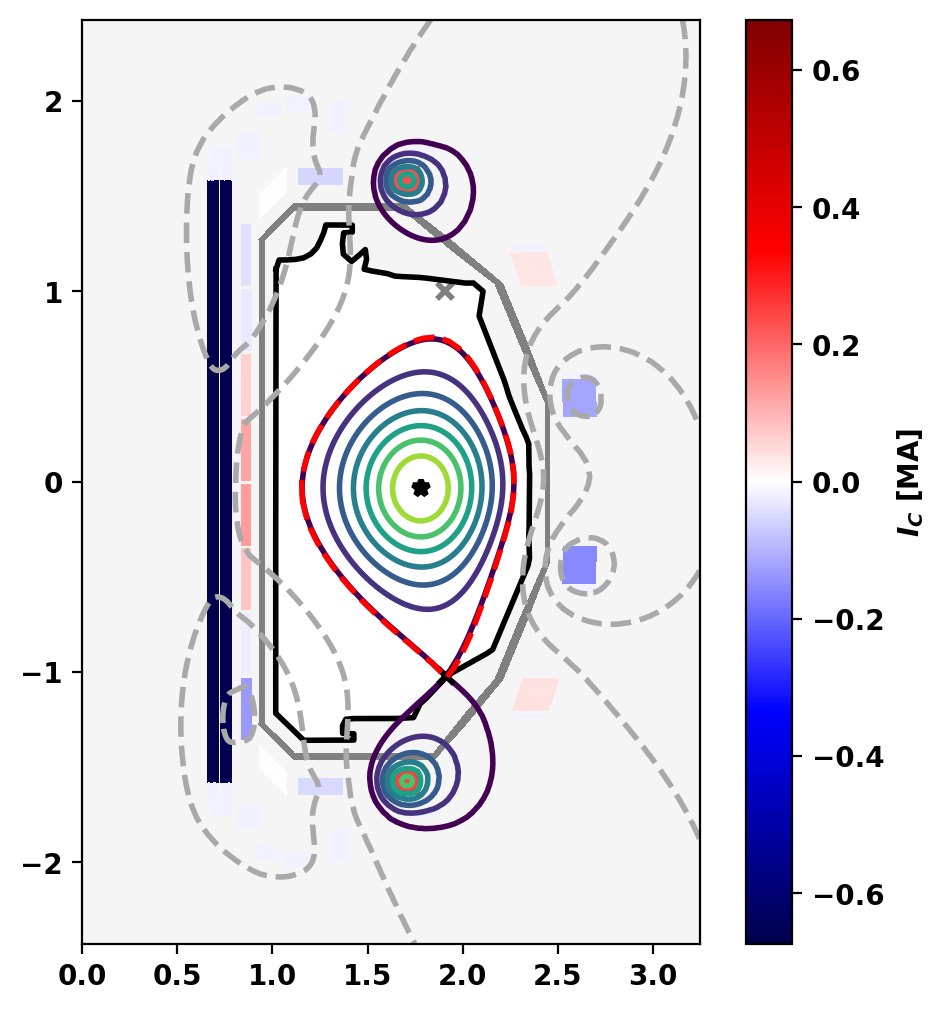
Print equilibrium information and coil currents
Basic parameters can be displayed using the print_info() method. For access to these quantities as variables instead the get_stats() can be used.
The final coil currents can also be retrieved using the get_coil_currents() method. Here, we plot the deviation of the TokaMaker currents from the desired target currents set above.
Equilibrium Statistics: Topology = Diverted Toroidal Current [A] = 4.9332E+05 Current Centroid [m] = 1.758 -0.042 Magnetic Axis [m] = 1.780 -0.036 Elongation = 1.598 (U: 1.412, L: 1.784) Triangularity = -0.296 (U: -0.224, L: -0.368) Plasma Volume [m^3] = 14.397 q_0, q_95 = 0.849 5.386 Plasma Pressure [Pa] = Axis: 6.8216E+03, Peak: 6.8216E+03 Stored Energy [J] = 3.9480E+04 <Beta_pol> [%] = 23.4009 <Beta_tor> [%] = 0.1278 <Beta_n> [%] = 0.2731 Diamagnetic flux [Wb] = 6.1406E-03 Toroidal flux [Wb] = 2.5085E+00 l_i = 1.6478 F1A: 116.35 115.97 0.33 F2A: 59.63 59.81 0.30 F3A: -31.07 -30.76 1.02 F4A: -40.38 -40.11 0.67 F5A: 0.72 0.72 0.00 F6A: -118.52 -117.86 0.56 F7A: 33.38 34.13 2.19 F8A: -56.96 -56.60 0.63 F9A: 232.86 236.63 1.59 F1B: 129.24 128.37 0.68 F2B: 76.90 76.37 0.70 F3B: -22.17 -22.35 0.80 F4B: -133.15 -133.14 0.00 F5B: 0.40 0.40 0.00 F6B: -153.10 -153.57 0.30 F7B: 41.11 41.51 0.97 F8B: -51.62 -51.39 0.46 F9B: 255.11 252.38 1.08 ECOILA: -16.03 -16.03 0.00 ECOILB: -15.78 -15.78 0.00
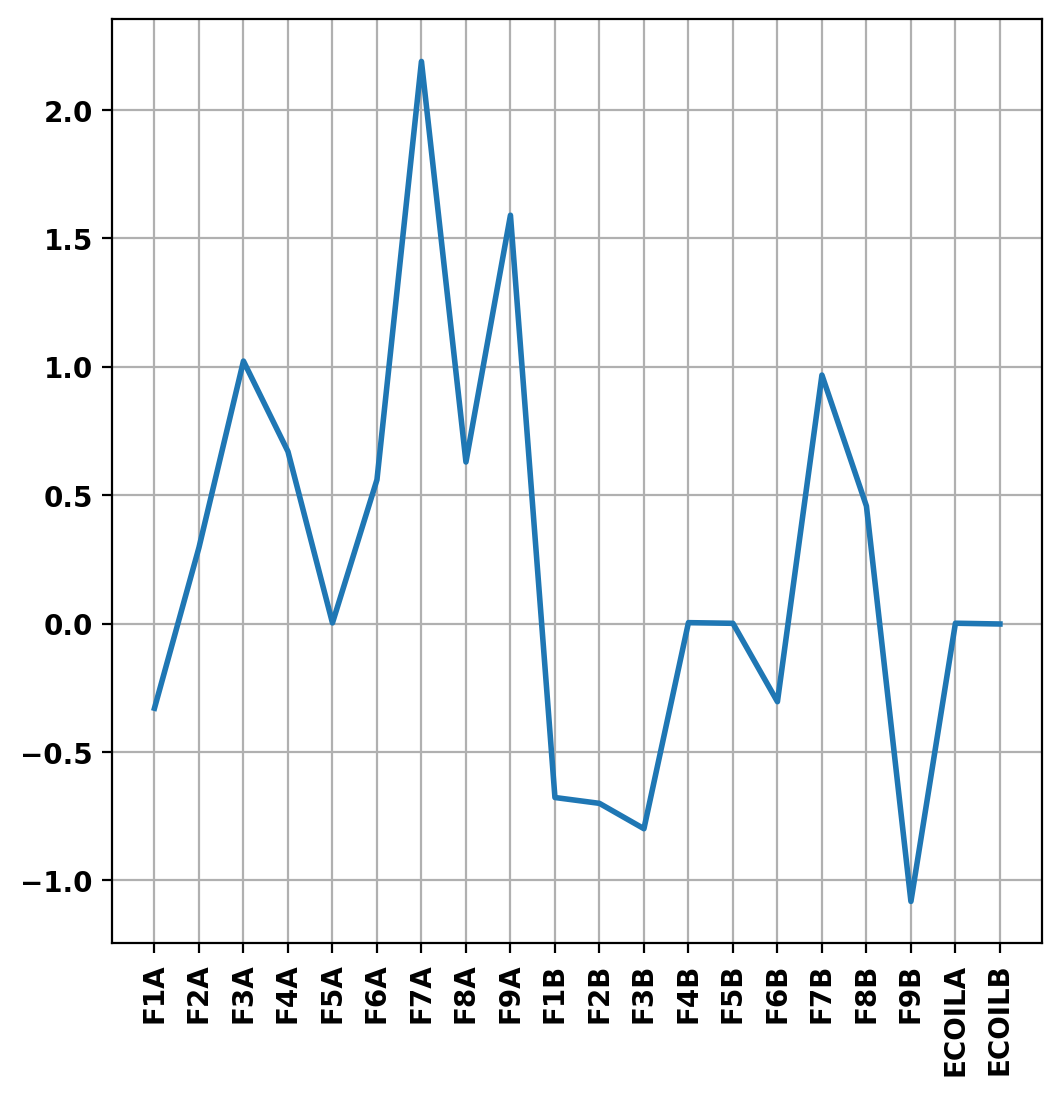
Retrieve profile information
Here, we use get_profiles() and get_q()to obtain the profiles of our equilibrium and compare them to the profiles of the target gEQDSK.
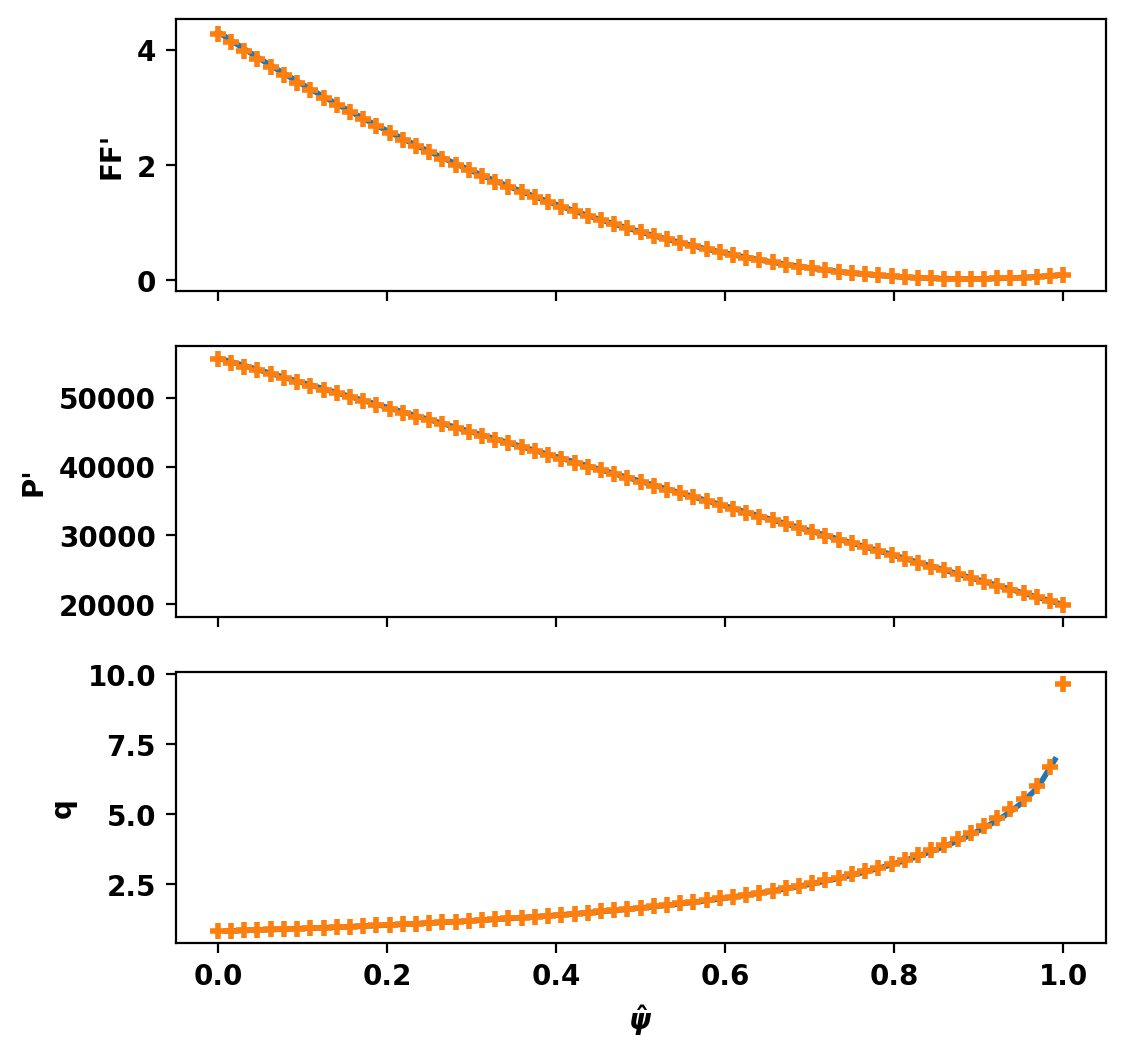
Compute Forward (Direct) Equilibrium
Instead of using a coil regularization matrix to reach the desired coil currents, the target coil current values can also be set directly using the set_coil_currents() method. For a direct solve such as this, the isoflux and saddle constraints previously imposed should be removed. We also set new global targets to constrain the axis pressure and vertical position.
Compute equilibrium
Starting non-linear GS solver
1 -2.0137E+00 -1.2595E-06 1.2956E-04 1.7801E+00 -3.5537E-02 -4.7738E+03
2 -2.0243E+00 -1.2630E-06 4.5152E-04 1.7804E+00 -3.6420E-02 -1.2555E+04
3 -2.0736E+00 -1.2760E-06 1.5659E-04 1.7810E+00 -3.7484E-02 -8.6298E+03
4 -2.0814E+00 -1.2580E-06 1.1574E-04 1.7815E+00 -3.8576E-02 -7.7634E+03
5 -2.0843E+00 -1.2534E-06 1.0200E-04 1.7821E+00 -3.9676E-02 -7.4551E+03
6 -2.0879E+00 -1.2528E-06 1.0519E-04 1.7825E+00 -4.0779E-02 -7.1880E+03
7 -2.0916E+00 -1.2524E-06 1.5420E-04 1.7830E+00 -4.2057E-02 -8.4448E+03
8 -2.1038E+00 -1.2549E-06 6.0032E-04 1.7835E+00 -4.2138E-02 4.2058E+03
9 -2.0424E+00 -1.2290E-06 2.0731E-04 1.7837E+00 -4.2154E-02 -3.0018E+03
10 -2.0479E+00 -1.2543E-06 6.3538E-05 1.7839E+00 -4.2157E-02 -2.7746E+03
11 -2.0500E+00 -1.2556E-06 2.7999E-05 1.7841E+00 -4.2158E-02 -2.5962E+03
12 -2.0498E+00 -1.2546E-06 2.2575E-05 1.7843E+00 -4.2158E-02 -2.5999E+03
13 -2.0500E+00 -1.2544E-06 2.1837E-05 1.7845E+00 -4.2158E-02 -2.5950E+03
14 -2.0502E+00 -1.2543E-06 2.8517E-05 1.7847E+00 -4.2158E-02 -2.6250E+03
15 -2.0506E+00 -1.2542E-06 2.3518E-05 1.7849E+00 -4.2158E-02 -2.6149E+03
16 -2.0510E+00 -1.2541E-06 2.6083E-05 1.7850E+00 -4.2159E-02 -2.5706E+03
17 -2.0515E+00 -1.2539E-06 2.1792E-05 1.7852E+00 -4.2159E-02 -2.5705E+03
18 -2.0517E+00 -1.2537E-06 1.4458E-05 1.7853E+00 -4.2159E-02 -2.5662E+03
19 -2.0518E+00 -1.2535E-06 1.3539E-05 1.7855E+00 -4.2159E-02 -2.5551E+03
20 -2.0519E+00 -1.2535E-06 1.4548E-05 1.7856E+00 -4.2159E-02 -2.5670E+03
21 -2.0522E+00 -1.2534E-06 1.6743E-05 1.7857E+00 -4.2159E-02 -2.5536E+03
22 -2.0523E+00 -1.2533E-06 1.6311E-05 1.7858E+00 -4.2159E-02 -2.5612E+03
23 -2.0525E+00 -1.2532E-06 9.7082E-06 1.7859E+00 -4.2159E-02 -2.5647E+03
24 -2.0527E+00 -1.2532E-06 1.1528E-05 1.7860E+00 -4.2159E-02 -2.5744E+03
25 -2.0528E+00 -1.2531E-06 1.6957E-05 1.7861E+00 -4.2159E-02 -2.5705E+03
26 -2.0531E+00 -1.2531E-06 1.6802E-05 1.7861E+00 -4.2159E-02 -2.5629E+03
27 -2.0533E+00 -1.2530E-06 1.2792E-05 1.7862E+00 -4.2159E-02 -2.5687E+03
28 -2.0534E+00 -1.2530E-06 1.7785E-05 1.7863E+00 -4.2159E-02 -2.5593E+03
29 -2.0536E+00 -1.2529E-06 1.6300E-05 1.7864E+00 -4.2159E-02 -2.5410E+03
30 -2.0537E+00 -1.2529E-06 1.5765E-05 1.7864E+00 -4.2159E-02 -2.5319E+03
31 -2.0539E+00 -1.2528E-06 9.3532E-06 1.7865E+00 -4.2159E-02 -2.5242E+03
32 -2.0539E+00 -1.2527E-06 9.6777E-06 1.7866E+00 -4.2159E-02 -2.5233E+03
33 -2.0541E+00 -1.2528E-06 1.0426E-05 1.7866E+00 -4.2159E-02 -2.5116E+03
34 -2.0543E+00 -1.2527E-06 1.0136E-05 1.7867E+00 -4.2159E-02 -2.5265E+03
35 -2.0545E+00 -1.2527E-06 4.3841E-06 1.7867E+00 -4.2159E-02 -2.5351E+03
36 -2.0546E+00 -1.2527E-06 1.0404E-05 1.7867E+00 -4.2159E-02 -2.5347E+03
37 -2.0547E+00 -1.2526E-06 9.2006E-06 1.7868E+00 -4.2159E-02 -2.5311E+03
38 -2.0547E+00 -1.2526E-06 3.5156E-06 1.7868E+00 -4.2159E-02 -2.5255E+03
39 -2.0548E+00 -1.2526E-06 9.2578E-06 1.7869E+00 -4.2159E-02 -2.5262E+03
40 -2.0548E+00 -1.2525E-06 3.2335E-06 1.7869E+00 -4.2159E-02 -2.5102E+03
41 -2.0548E+00 -1.2525E-06 9.0317E-06 1.7869E+00 -4.2159E-02 -2.5111E+03
42 -2.0548E+00 -1.2525E-06 3.0114E-06 1.7869E+00 -4.2159E-02 -2.5198E+03
43 -2.0548E+00 -1.2525E-06 5.6320E-06 1.7870E+00 -4.2159E-02 -2.5194E+03
44 -2.0549E+00 -1.2525E-06 5.3106E-06 1.7870E+00 -4.2159E-02 -2.5216E+03
45 -2.0549E+00 -1.2525E-06 1.0432E-05 1.7870E+00 -4.2159E-02 -2.5184E+03
46 -2.0549E+00 -1.2525E-06 6.1186E-06 1.7870E+00 -4.2159E-02 -2.5174E+03
47 -2.0549E+00 -1.2525E-06 1.4365E-05 1.7871E+00 -4.2159E-02 -2.5191E+03
48 -2.0551E+00 -1.2525E-06 1.4332E-05 1.7871E+00 -4.2159E-02 -2.5326E+03
49 -2.0553E+00 -1.2525E-06 5.3658E-06 1.7871E+00 -4.2159E-02 -2.5386E+03
50 -2.0555E+00 -1.2524E-06 1.4133E-05 1.7871E+00 -4.2159E-02 -2.5419E+03
51 -2.0557E+00 -1.2524E-06 3.7620E-06 1.7872E+00 -4.2159E-02 -2.5605E+03
52 -2.0558E+00 -1.2523E-06 1.5590E-05 1.7872E+00 -4.2159E-02 -2.5609E+03
53 -2.0559E+00 -1.2523E-06 3.9554E-06 1.7872E+00 -4.2159E-02 -2.5514E+03
54 -2.0560E+00 -1.2522E-06 2.4260E-06 1.7872E+00 -4.2159E-02 -2.5527E+03
55 -2.0560E+00 -1.2522E-06 5.0169E-06 1.7873E+00 -4.2159E-02 -2.5531E+03
56 -2.0560E+00 -1.2522E-06 2.1940E-06 1.7873E+00 -4.2159E-02 -2.5605E+03
57 -2.0561E+00 -1.2522E-06 1.7743E-06 1.7873E+00 -4.2159E-02 -2.5605E+03
58 -2.0561E+00 -1.2522E-06 1.5630E-06 1.7873E+00 -4.2159E-02 -2.5606E+03
59 -2.0562E+00 -1.2522E-06 1.3824E-06 1.7873E+00 -4.2159E-02 -2.5607E+03
60 -2.0562E+00 -1.2521E-06 1.2228E-06 1.7874E+00 -4.2159E-02 -2.5608E+03
61 -2.0562E+00 -1.2521E-06 6.4068E-06 1.7874E+00 -4.2159E-02 -2.5609E+03
62 -2.0562E+00 -1.2521E-06 1.7075E-06 1.7874E+00 -4.2159E-02 -2.5701E+03
63 -2.0563E+00 -1.2521E-06 1.0225E-06 1.7874E+00 -4.2159E-02 -2.5697E+03
64 -2.0563E+00 -1.2521E-06 4.7539E-06 1.7874E+00 -4.2159E-02 -2.5697E+03
65 -2.0563E+00 -1.2521E-06 4.5549E-06 1.7874E+00 -4.2159E-02 -2.5641E+03
66 -2.0563E+00 -1.2521E-06 1.2642E-06 1.7874E+00 -4.2159E-02 -2.5724E+03
67 -2.0563E+00 -1.2521E-06 7.8325E-07 1.7874E+00 -4.2159E-02 -2.5720E+03
Timing: 0.74570699996547773
Source: 0.30776199983665720
Solve: 0.33583900035591796
Boundary: 2.4080999719444662E-002
Other: 7.8025000053457916E-002
Print equilibrium information and coil currents
Here we plot the output of the direct solve, which shows close agreement with the desired plasma boundary. We also print the equilibrium information and plot the error in the coil currents. Because the coil currents were set explicitely, there is no deviation between the target and actual currents, except in the vertical stability coil pair.
[<matplotlib.lines.Line2D at 0x134bd8b90>]
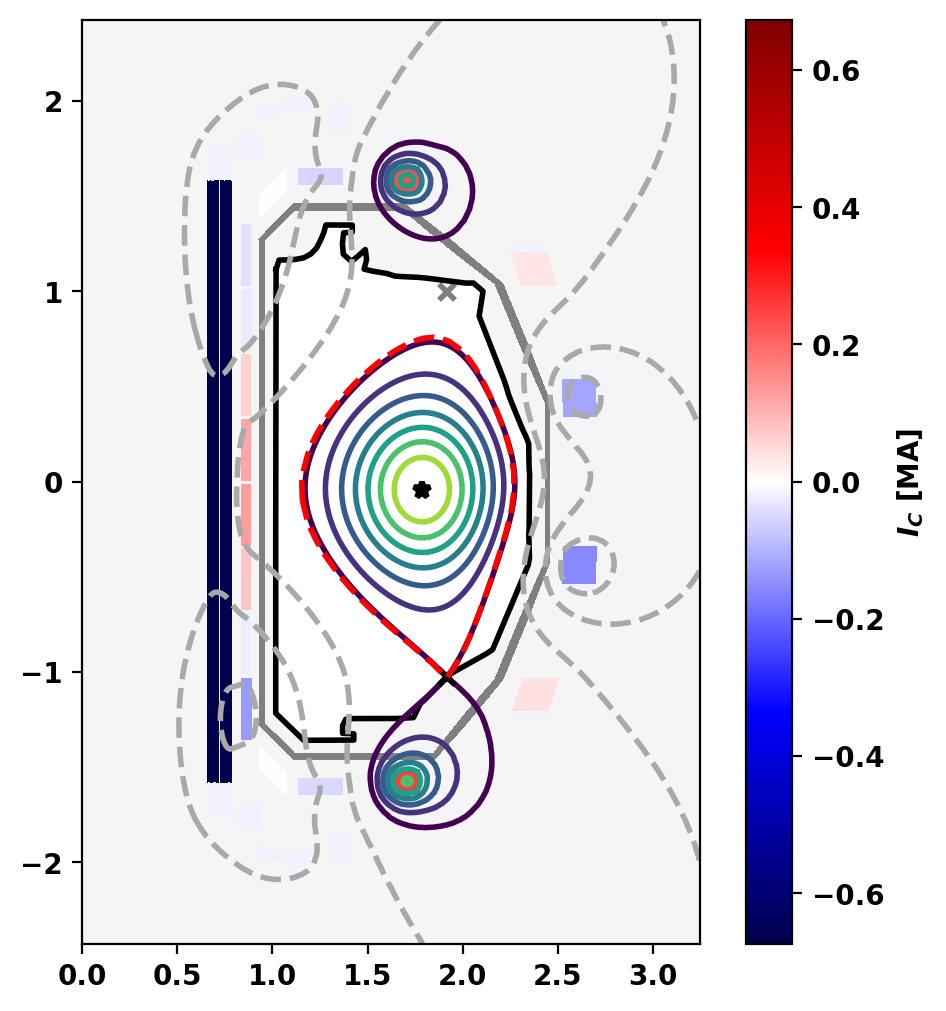
Equilibrium Statistics: Topology = Limited Toroidal Current [A] = 4.9332E+05 Current Centroid [m] = 1.766 -0.048 Magnetic Axis [m] = 1.787 -0.042 Elongation = 1.603 (U: 1.408, L: 1.798) Triangularity = -0.286 (U: -0.210, L: -0.362) Plasma Volume [m^3] = 14.283 q_0, q_95 = 0.829 5.251 Plasma Pressure [Pa] = Axis: 6.8216E+03, Peak: 6.8216E+03 Stored Energy [J] = 3.9108E+04 <Beta_pol> [%] = 22.9405 <Beta_tor> [%] = 0.1291 <Beta_n> [%] = 0.2718 Diamagnetic flux [Wb] = 6.1909E-03 Toroidal flux [Wb] = 2.4632E+00 l_i = 1.6428 F1A: 115.97 115.97 0.00 F2A: 59.81 59.81 0.00 F3A: -30.76 -30.76 0.00 F4A: -40.11 -40.11 0.00 F5A: 0.72 0.72 0.00 F6A: -117.86 -117.86 0.00 F7A: 34.13 34.13 0.00 F8A: -56.60 -56.60 0.00 F9A: 234.05 236.63 1.09 F1B: 128.37 128.37 0.00 F2B: 76.37 76.37 0.00 F3B: -22.35 -22.35 0.00 F4B: -133.14 -133.14 0.00 F5B: 0.40 0.40 0.00 F6B: -153.57 -153.57 0.00 F7B: 41.51 41.51 0.00 F8B: -51.39 -51.39 0.00 F9B: 254.95 252.38 1.02 ECOILA: -16.03 -16.03 0.00 ECOILB: -15.78 -15.78 0.00
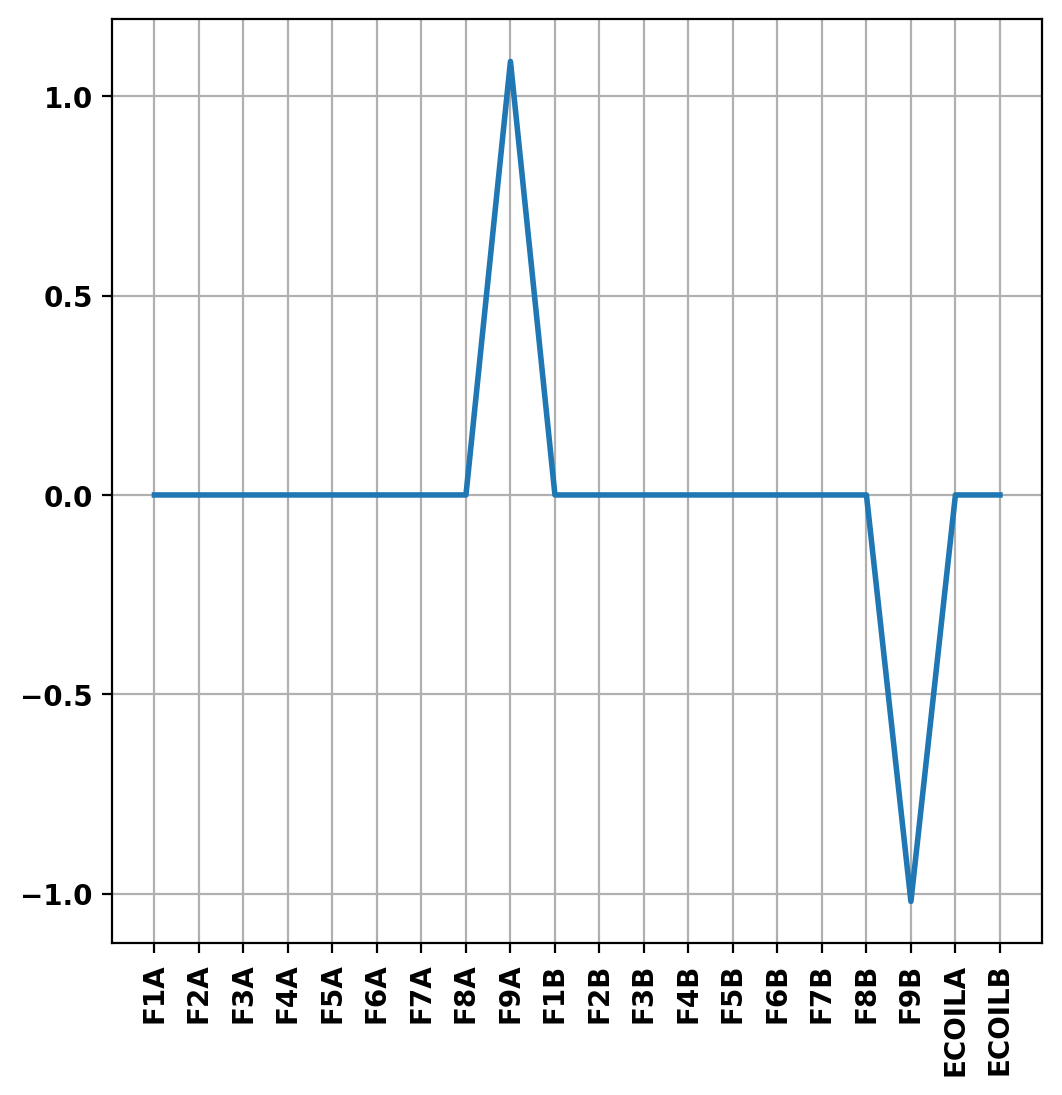
Save equilibrium as a gEQDSK file
We save our TokaMaker equilibrium as a gEQDSK file using the save_eqdsk() method. We modify the resolution of the equilibrium file by increasing the nr and nz parameters and decreasing the padding on the last closed flux surface (lcfs_pad).
Saving gEQDSK: g192185_tokamaker
Update equilibrium for linear stability
As is often the case with experimental equilibrium reconstructions, the profiles provided in the gEQDSK file have unrealistically high edge current ( \( F*F' \) and \( P' \) at the LCFS). To improve the behavior of the equilibrium during stability and time-dependent solves we apply a simple linear ramp to drop both \( F*F' \) and \( P' \) to zero at \( \hat{\psi} = 1 \).
- Warning
- Even when matching global quantities, this change will modify the stability and time-dependent properties of the equilibrium. Therefore care should always be taken with such a modification to avoid trading on unphysical profile for another.
Additionally, we change the form of our targets to use Ip_ratio instead of pax. This form allows us to later perform a VDE simulation with constant \( I_p \) and roughly constant \( \beta_p \).
We then recompute the equilibrium to prepare for time-dependent analysis.
Starting non-linear GS solver
1 -2.0641E+00 -1.3630E-06 1.6090E-04 1.7878E+00 -4.2159E-02 -4.0962E+03
2 -2.0459E+00 -1.3506E-06 6.6897E-05 1.7881E+00 -4.2159E-02 -4.3025E+03
3 -2.0373E+00 -1.3471E-06 3.5098E-05 1.7883E+00 -4.2159E-02 -4.3272E+03
4 -2.0332E+00 -1.3458E-06 2.1819E-05 1.7885E+00 -4.2159E-02 -4.3284E+03
5 -2.0314E+00 -1.3453E-06 1.6475E-05 1.7887E+00 -4.2159E-02 -4.3270E+03
6 -2.0306E+00 -1.3450E-06 1.4258E-05 1.7889E+00 -4.2159E-02 -4.3261E+03
7 -2.0304E+00 -1.3449E-06 1.3049E-05 1.7890E+00 -4.2159E-02 -4.3255E+03
8 -2.0304E+00 -1.3448E-06 1.2141E-05 1.7892E+00 -4.2159E-02 -4.3253E+03
9 -2.0305E+00 -1.3447E-06 1.1339E-05 1.7893E+00 -4.2159E-02 -4.3254E+03
10 -2.0307E+00 -1.3446E-06 1.0597E-05 1.7894E+00 -4.2159E-02 -4.3255E+03
11 -2.0309E+00 -1.3446E-06 9.9013E-06 1.7896E+00 -4.2159E-02 -4.3256E+03
12 -2.0311E+00 -1.3445E-06 9.2487E-06 1.7897E+00 -4.2159E-02 -4.3257E+03
13 -2.0313E+00 -1.3445E-06 8.6376E-06 1.7898E+00 -4.2159E-02 -4.3257E+03
14 -2.0314E+00 -1.3445E-06 8.0659E-06 1.7899E+00 -4.2159E-02 -4.3258E+03
15 -2.0316E+00 -1.3444E-06 7.5326E-06 1.7900E+00 -4.2159E-02 -4.3260E+03
16 -2.0318E+00 -1.3444E-06 7.0351E-06 1.7900E+00 -4.2159E-02 -4.3262E+03
17 -2.0319E+00 -1.3444E-06 6.5703E-06 1.7901E+00 -4.2159E-02 -4.3263E+03
18 -2.0320E+00 -1.3444E-06 6.1358E-06 1.7902E+00 -4.2159E-02 -4.3265E+03
19 -2.0322E+00 -1.3443E-06 5.7299E-06 1.7903E+00 -4.2159E-02 -4.3267E+03
20 -2.0323E+00 -1.3443E-06 5.3509E-06 1.7903E+00 -4.2159E-02 -4.3268E+03
21 -2.0324E+00 -1.3443E-06 4.9972E-06 1.7904E+00 -4.2159E-02 -4.3270E+03
22 -2.0325E+00 -1.3443E-06 4.6666E-06 1.7904E+00 -4.2159E-02 -4.3272E+03
23 -2.0326E+00 -1.3442E-06 4.3580E-06 1.7905E+00 -4.2159E-02 -4.3273E+03
24 -2.0327E+00 -1.3442E-06 4.0698E-06 1.7905E+00 -4.2159E-02 -4.3274E+03
25 -2.0328E+00 -1.3442E-06 3.8007E-06 1.7906E+00 -4.2159E-02 -4.3275E+03
26 -2.0329E+00 -1.3442E-06 3.5495E-06 1.7906E+00 -4.2159E-02 -4.3276E+03
27 -2.0329E+00 -1.3442E-06 3.3146E-06 1.7907E+00 -4.2159E-02 -4.3278E+03
28 -2.0330E+00 -1.3442E-06 3.0949E-06 1.7907E+00 -4.2159E-02 -4.3279E+03
29 -2.0331E+00 -1.3442E-06 2.8897E-06 1.7907E+00 -4.2159E-02 -4.3280E+03
30 -2.0331E+00 -1.3441E-06 2.6981E-06 1.7908E+00 -4.2159E-02 -4.3281E+03
31 -2.0332E+00 -1.3441E-06 2.5190E-06 1.7908E+00 -4.2159E-02 -4.3282E+03
32 -2.0332E+00 -1.3441E-06 2.3520E-06 1.7908E+00 -4.2159E-02 -4.3283E+03
33 -2.0333E+00 -1.3441E-06 2.1961E-06 1.7909E+00 -4.2159E-02 -4.3284E+03
34 -2.0333E+00 -1.3441E-06 2.0508E-06 1.7909E+00 -4.2159E-02 -4.3285E+03
35 -2.0334E+00 -1.3441E-06 1.9149E-06 1.7909E+00 -4.2159E-02 -4.3286E+03
36 -2.0334E+00 -1.3441E-06 1.7881E-06 1.7909E+00 -4.2159E-02 -4.3287E+03
37 -2.0335E+00 -1.3441E-06 1.6695E-06 1.7910E+00 -4.2159E-02 -4.3288E+03
38 -2.0335E+00 -1.3441E-06 1.5587E-06 1.7910E+00 -4.2159E-02 -4.3288E+03
39 -2.0335E+00 -1.3441E-06 1.4553E-06 1.7910E+00 -4.2159E-02 -4.3289E+03
40 -2.0335E+00 -1.3441E-06 1.3586E-06 1.7910E+00 -4.2159E-02 -4.3290E+03
41 -2.0336E+00 -1.3441E-06 1.2683E-06 1.7910E+00 -4.2159E-02 -4.3290E+03
42 -2.0336E+00 -1.3441E-06 1.1840E-06 1.7910E+00 -4.2159E-02 -4.3291E+03
43 -2.0336E+00 -1.3441E-06 1.1053E-06 1.7910E+00 -4.2159E-02 -4.3291E+03
44 -2.0337E+00 -1.3441E-06 1.0319E-06 1.7911E+00 -4.2159E-02 -4.3292E+03
45 -2.0337E+00 -1.3441E-06 9.6340E-07 1.7911E+00 -4.2159E-02 -4.3292E+03
Timing: 0.50464100000681356
Source: 0.20982700004242361
Solve: 0.22672400006558746
Boundary: 1.5833999961614609E-002
Other: 5.2255999937187880E-002
Plot profile information
Again we use get_profiles() to compare the updated profiles with the initial gEQDSK profiles and visualize the local modifications introduced at the edge.
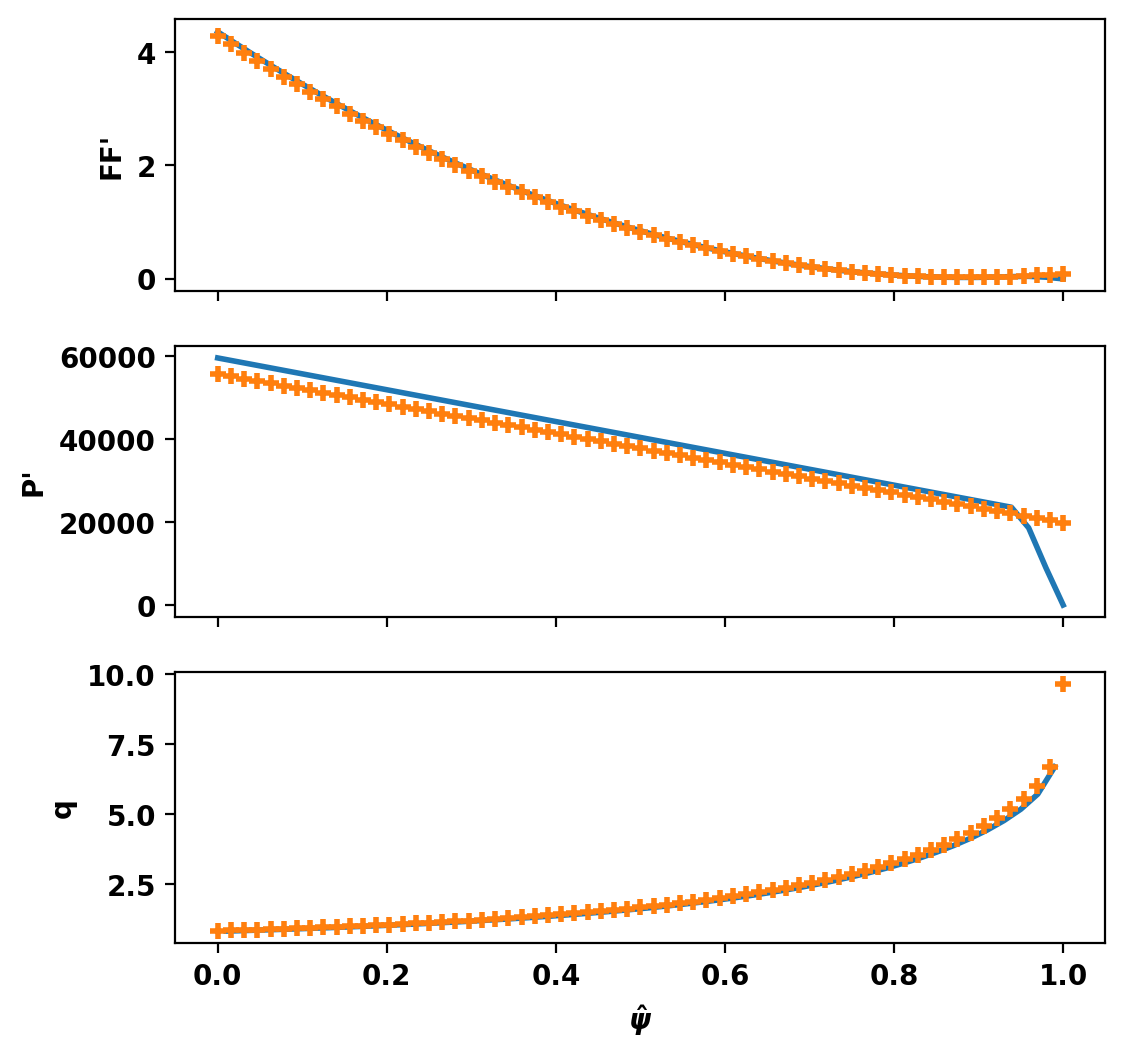
Linear Stability Analysis
We can compute the most unstable eigenmodes of the linearized system along with their eigenvalues, or growth rates, using the eig_td() method. In this case, the most unstable mode corresponds to vertical instability, and has a growth rate of ~807 s^-1.
We also plot the vertically unstable mode and the eddy currents in conducting structures using the plot_eddy() method.
Growth rate = 9.4598E+02 [s^-1] Growth time = 1.0571E-03 [s]

Time-dependent VDE simulation
A VDE can be initiated by extracting the original equilibrium \(\psi\) using get_psi() and adding a perturbation corresponding to the vertically unstable eigenmode. Then, set_psi() can be used to set this modified equilibrium as the initial condition for the time dependent simulation. The modified equilibrium is visualized below.
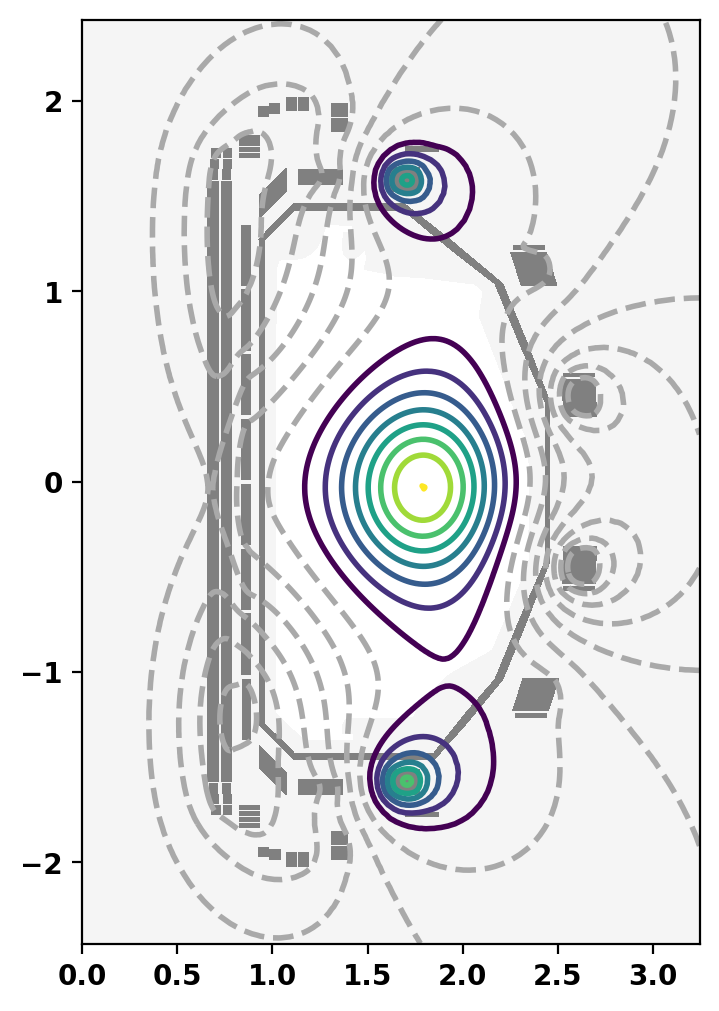
Setup simulation
In order to run the time-dependent simulation, the isoflux constraints are removed and the setup_td() method is run to set the initial timestep and tolerances for the solver. A timestep is chosen that aligns with the predicted growth time of the unstable mode.
Perform time-dependent simulation
To run the simulation, step_td() is run for the desired number of timesteps. At each timestep, we save \(\psi\) as well as the vertical position of the magnetic axis and the amplitude of the vertically unstable eigenmode.
1.05711E-04 1.05711E-04 2 16 0.320 0 3.17132E-04 1.05711E-04 2 15 0.247 0 5.28554E-04 1.05711E-04 2 16 0.172 0 7.39976E-04 1.05711E-04 2 16 0.169 0 9.51397E-04 1.05711E-04 2 16 0.168 0 1.16282E-03 1.05711E-04 2 17 0.178 0 1.37424E-03 1.05711E-04 2 18 0.186 0 1.58566E-03 1.05711E-04 2 18 0.195 0 1.79708E-03 1.05711E-04 2 18 0.188 0 2.00851E-03 1.05711E-04 2 18 0.188 0 2.21993E-03 1.05711E-04 2 18 0.188 0 2.43135E-03 1.05711E-04 2 18 0.190 0 2.64277E-03 1.05711E-04 2 18 0.187 0 2.85419E-03 1.05711E-04 3 25 0.260 0 3.06561E-03 1.05711E-04 2 19 0.196 0 3.27704E-03 1.05711E-04 2 19 0.195 0 3.48846E-03 1.05711E-04 2 19 0.194 0 3.69988E-03 1.05711E-04 2 19 0.199 0 3.91130E-03 1.05711E-04 2 19 0.193 0 4.12272E-03 1.05711E-04 3 27 0.268 0 Total time = 8.046
Plot evolution of flux surfaces
We plot the last closed flux surface at each timestep to visualize the plasma evolution.
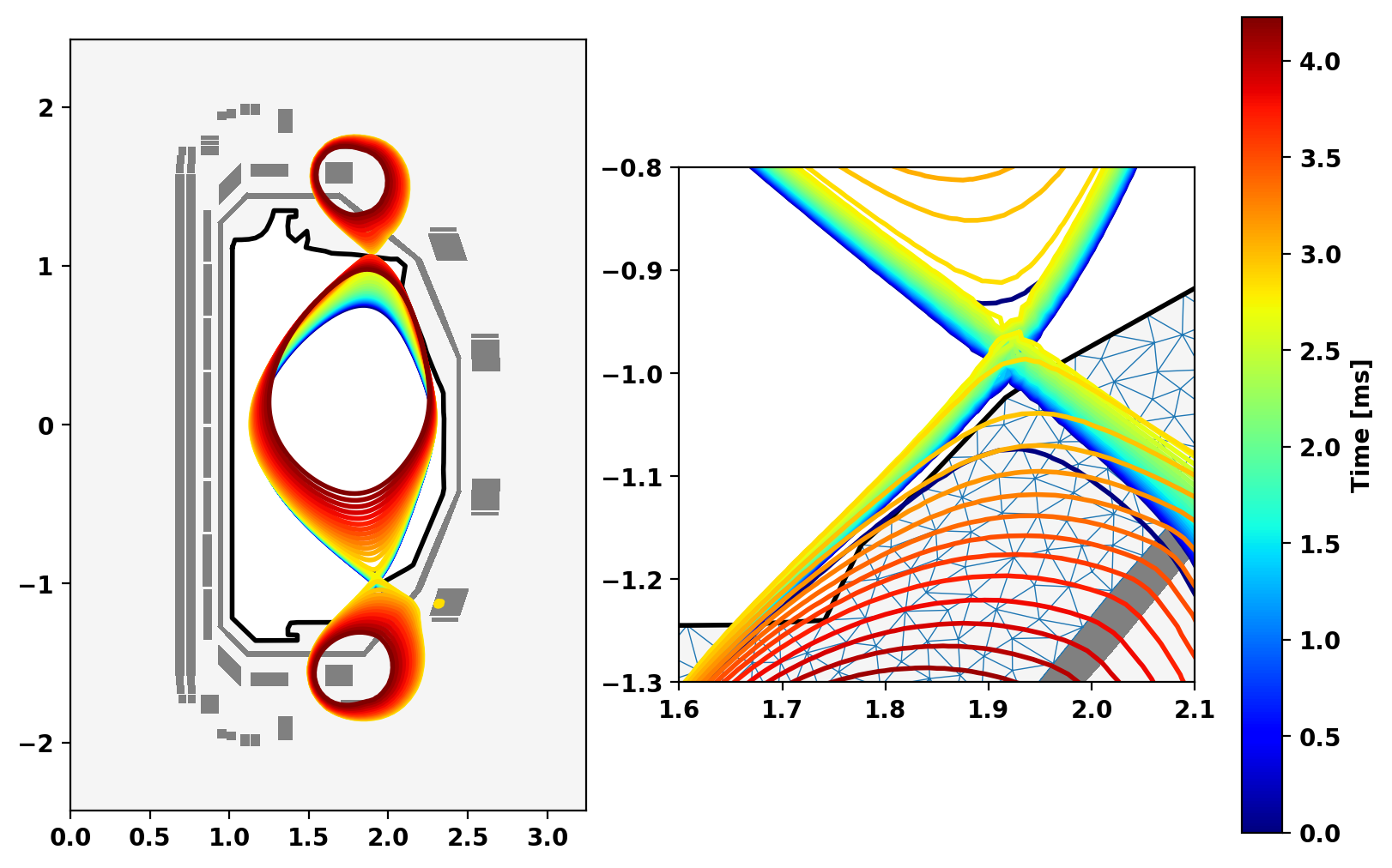
Plot time-evolution of equilibrium
Here we plot the evolution of the vertical position of the plasma and the amplitude of the computed eigenvector from above in the solution (as compared to the initial state). Both of these values should grow linearly at the predicted growth rate (shown in orange).
